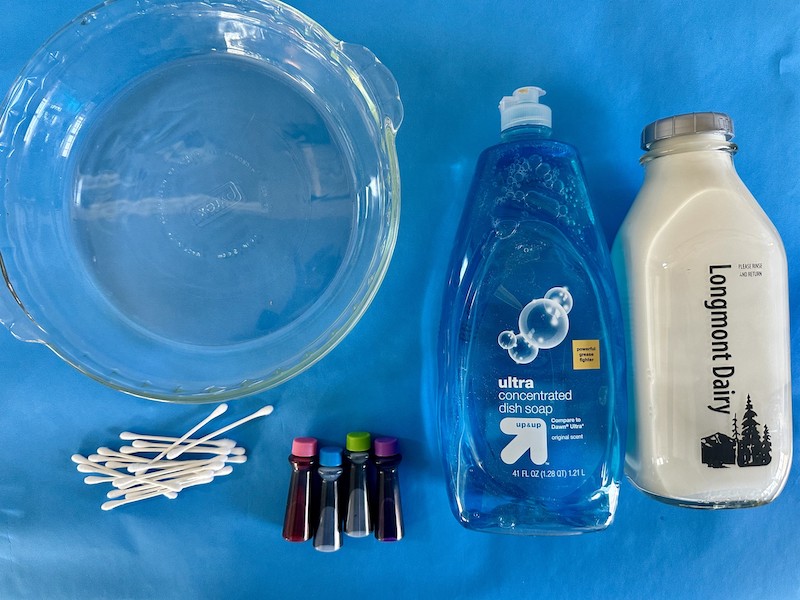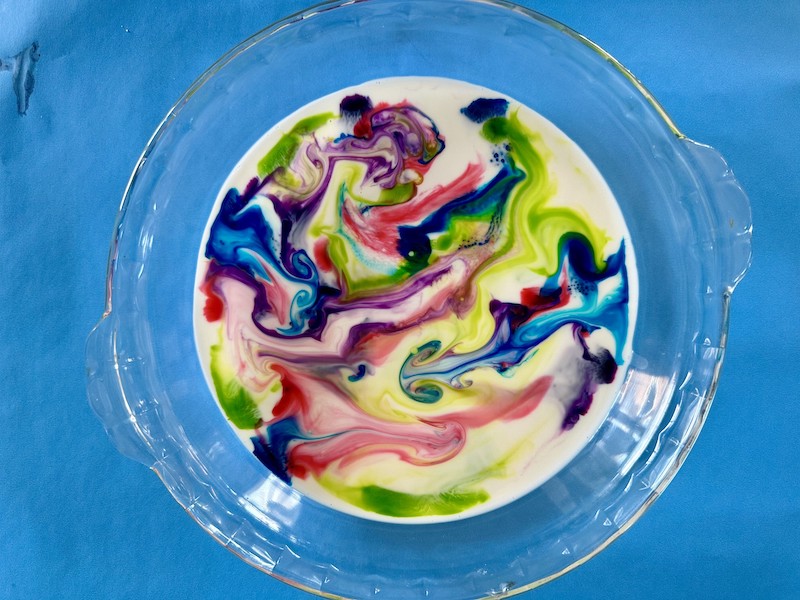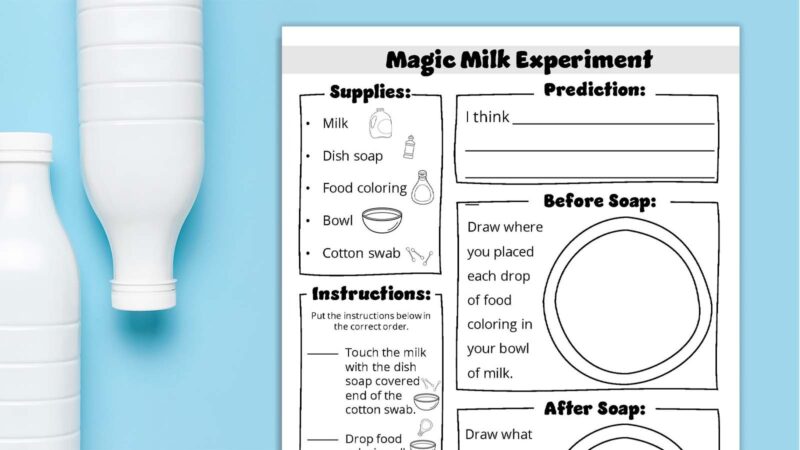
- Science Notes Posts
- Contact Science Notes
- Todd Helmenstine Biography
- Anne Helmenstine Biography
- Free Printable Periodic Tables (PDF and PNG)
- Periodic Table Wallpapers
- Interactive Periodic Table
- Periodic Table Posters
- Science Experiments for Kids
- How to Grow Crystals
- Chemistry Projects
- Fire and Flames Projects
- Holiday Science
- Chemistry Problems With Answers
- Physics Problems
- Unit Conversion Example Problems
- Chemistry Worksheets
- Biology Worksheets
- Periodic Table Worksheets
- Physical Science Worksheets
- Science Lab Worksheets
- My Amazon Books

Magic Milk Science Experiment for Kids

Nothing happens if you drip food coloring onto milk, but once you add a drop of dishwashing liquid, the milk turns into a swirling wheel of color. Here’s how to perform the magic milk science experiment and a look at how it works.
Magic Milk Materials
This is a great science project for kids because all you need is milk, food coloring, and dishwashing liquid. It’s also easy on your pocketbook because you only need a little of the ingredients.
- Food Coloring
- Dishwashing liquid
How to Do the Magic Milk Science Experiment
- Pour enough milk to cover the bottom of a small place or shallow saucer.
- Add a few drops of food coloring. You don’t need to use different colors, but if you do, you can explore how colors combine to make new ones.
- Observe how boring this is. The food coloring drops stay where you put them and may even sink into the milk and disappear.
- Drip a droplet of dishwashing liquid onto the center of the milk. You don’t need to stir the milk. The colors immediately start to swirl on their own.
How the Magic Milk Experiment Works
Adding food coloring to milk doesn’t have much of an effect. Yes, you can color the milk if you stir it, but if you don’t stir it the color spreads by diffusion . Diffusion is a slow process and not very interesting to watch.
When you add dishwashing liquid, the colors start to swirl. Dishwashing liquid is a detergent. Detergents lower the surface tension of the water in the milk, making it easier for the ingredients on the plate to mix. You can observe surface tension if you pour water or milk into a glass and note you can overfill the container slightly. The anti-gravity water science trick also relies on surface tension.
But, that’s not all detergent does. Detergent is an emulsifier . Each detergent molecule has a hydrophobic (“water-fearing”) and hydrophilic (“water-loving”) portion. The hydrophilic portion orients toward water molecules, while the hydrophobic portion orients toward fat molecules. The end result is that detergent forms tiny spheres called micelles that separate the fat from the water. Basically, an emulsifier helps two immiscible (unmixable) liquids mix. The food coloring swirls throughout the milk as the detergent forms micelles around fat globules within it. The fat content of the milk matters. Skim milk contains very little fat, so the detergent doesn’t have a big effect on it. 2% milk and whole milk work much better for the magic milk project because they contain enough fat to cause a visible reaction between the detergent and milk.
From Project to Science Experiment
Science projects work due to scientific principles. For young explorers, you can explain that detergent changes the properties of milk so colors added to it mix better. Explain that the same process happens when you wash dishes. The detergent makes it easier for oil and grease to lift from dishes and get rinsed away. Also, this is a great project for kids to explore colors. They can see that blue and yellow combine to make green, red and blue combine to make purple, and so on.
But, older children can turn the science project into a science experiment. The difference is that an experiment uses the scientific method . In a nutshell, an investigator observes the project, makes a prediction or forms a hypothesis about what will happen if one thing is changed, and then conducts and experiment to see if the prediction was correct. Here are some ideas of factors to change to turn the magic milk project into a true magic milk science experiment.
- What happens if you increase the fat content of milk? You can compare skim, 2% milk, whole milk, and half-and-half. Or, you can mix oil in with milk before continuing the project. Is there a point where the thickness of the milk slows down the reaction?
- Does the project work with water? With vegetable oil? What happens if you mix water and oil and try the project?
- What happens if you sprinkle glitter onto the milk before adding the detergent?
- Temperature affects the rate of many processes and chemical reactions. Is there any difference if you use very color milk compared with hot milk?
Related Posts
- Grades 6-12
- School Leaders
Don’t Miss Our List of the Top 2024-25 Competitions for Students in Grades K-12! 🏆
Magic Milk Experiment: How-To Plus Free Worksheet
This classic experiment teaches kids about basic chemistry and physics.

This fun experiment is a classic for a reason! In the magic milk experiment, kids learn about simple chemical reactions and physical properties using only a few ingredients. Read on to see how to do the experiment, and fill out the form on this page to grab your free recording sheet.
How does the magic milk experiment work?
In this experiment, you pour some milk into a shallow dish. You then add drops of food coloring to the surface of the milk. Using a cotton swab dipped into dish soap, you lightly brush the surface of the milk. The dish soap breaks the surface tension of the milk, and the soap molecules try to attach to the fat molecules in the milk. This causes swirls and bursts of fun rainbow colors.
What does the magic milk experiment teach?
This experiment teaches us about the science of molecules and how substances interact. The soap breaks down the fat molecules and makes them move apart, showing us a simple but fascinating example of chemistry in action!
Is there a magic milk video?
This video shows two different ways to do the magic milk science experiment, using very similar ingredients.
Materials Needed

To do the magic milk experiment, you will need:
- Shallow bowl or plate
- Milk, blue dish soap
- Cotton swabs
- Food coloring (inexpensive works better than gel coloring)
Our free recording sheet is also helpful— fill out the form on this page to get it.

Magic milk experiment steps:
1. pour milk into a shallow dish or bowl, just enough to cover the bottom..

2. Add drops of food coloring all over the surface of the milk.

3. Dip the end of a cotton swab into a separate dish of blue soap.

4. Lightly brush the top of the milk with the cotton swab, and watch what happens!

Grab our free magic milk experiment worksheet!

Fill out the form on this page to get your worksheet. The worksheet asks kids to guess the correct order of the steps in the experiment. Next, kids must make a prediction about what they think will happen. They can use the provided spaces to draw what happens before and after they add the dish soap. Did their predictions come true?
Additional Reflection Questions
- What happened when we added the soap to the milk?
- Why do you think the colors appeared on the milk’s surface?
- What do you think would happen if we added more soap to the milk?
- What do you think would happen if we used a different liquid instead of milk?
Can the magic milk experiment be done for a science fair?
Yes! If you want to do the magic milk experiment for a science fair, we recommend switching up some of the variables. For example: Does the fat content of the milk matter? Does the type of dish soap matter? Form a hypothesis about how changing the variables will impact the experiment. Good luck!
Looking for more experiment ideas? Check out our big list of experiment ideas here.
Plus, be sure to subscribe to our newsletters for more articles like this., you might also like.

72 Easy Science Experiments Using Materials You Already Have On Hand
Because science doesn't have to be complicated. Continue Reading
Copyright © 2024. All rights reserved. 5335 Gate Parkway, Jacksonville, FL 32256
- Book Lists by Age
- Book Lists by Category
- Reading Resources
- Language & Speech
- Raise a Reader Blog
- Back to School
- Success Guides by Grade
- Homework Help
- Social & Emotional Learning
- Activities for Kids
At-Home Science Experiments: Color-Changing Milk
Some very unusual things happen when you mix a little milk, food coloring, and a drop of dish detergent..
What You'll Need:
- Milk (whole or 2%)
- Dinner plate
- Food coloring (red, yellow, green, blue)
- Dishwashing soap (Dawn brand works well)
- Cotton swabs
What To Do:
- Pour enough milk in the dinner plate to completely cover the bottom to the depth of about 1/4". Allow the milk to settle.
- Add one drop of each of the four colors of food coloring — red, yellow, blue, and green — to the milk. Keep the drops close together in the center of the plate of milk.
- Find a clean cotton swab for the next part of the experiment. Predict what will happen when you touch the tip of the cotton swab to the center of the milk. It's important not to stir the mix. Just touch it with the tip of the cotton swab. Go ahead and try it. Did anything happen?
- Now place a drop of liquid dish soap on the other end of the cotton swab. Place the soapy end of the cotton swab back in the middle of the milk and hold it there for 10 to 15 seconds. Look at that burst of color! It's like the 4th of July in a bowl of milk!
- Add another drop of soap to the tip of the cotton swab and try it again. Experiment with placing the cotton swab at different places in the milk. Notice that the colors in the milk continue to move even when the cotton swab is removed. What makes the food coloring in the milk move?
What's Happening:
Milk is mostly water, but it also contains vitamins, minerals, proteins, and tiny droplets of fat suspended in solution. Fats and proteins are sensitive to changes in the surrounding solution (the milk). The secret of the bursting colors is the chemistry of that tiny drop of soap. Dish soap, because of its bipolar characteristics (nonpolar on one end and polar on the other), weakens the chemical bonds that hold the proteins and fats in solution. The soap's polar, or hydrophilic (water-loving), end dissolves in water, and its hydrophobic (water-fearing) end attaches to a fat globule in the milk. This is when the fun begins.
The molecules of fat bend, roll, twist, and contort in all directions as the soap molecules race around to join up with the fat molecules. During all of this fat molecule gymnastics, the food coloring molecules are bumped and shoved everywhere, providing an easy way to observe all the invisible activity. As the soap becomes evenly mixed with the milk, the action slows down and eventually stops.
Try adding another drop of soap to see if there's any more movement. If so, you discovered there are still more fat molecules that haven't found a partner at the big color dance. Add another drop of soap to start the process again.
This activity and images are courtesy of Steve Spangler Science .
PLUS: Mess-Free Experiments C old Weather Experiments F un Science Experiments for Kids
Shop STEM Resources

IMAGES
VIDEO